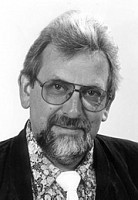BIOGRAPHY

1902-1965
Theo Ballmer is known as one of the heroes of Modernist design. His posters of the 1920s and ‘30s are famous, leaving his work as a photographer, lettering designer, teacher and jobbing typographer almost unrecorded. The shortest accounts of his career mention that he was a student at the Bauhaus. In fact, when he went to the Bauhaus he was already an established designer.
Born in Basel, and apprenticed as a lithographic draughtsman in that city, Ballmer received part of his training at the Zurich Kunstgewerbeschule, where one of his teachers was Ernst Keller, the ‘father of Swiss graphic design.’ Ballmer’s sketchbooks at the age of seventeen reveal him as astonishingly precocious and aware of the avant-garde. Drawings show the influence of George Grosz; an exercise in organizing different elements in a given space has hints of Mondrian, another of Kandinsky.
In 1926 Ballmer began work as graphic designer for one of Basel’s largest pharmaceutical companies, Hoffmann-La Roche. Here he employed Modernist ingredients – flat areas of colour and geometrical lettering drawn with ruler and compasses on a grid – which remained a continuing speciality and part of a personal style. The earliest published example of this lettering is in the design of a shop-window display of watches, made in collaboration with the architects Ernst Mumenthaler and Otto Meier, partners in a leading progressive architectural practice. Mumenthaler’s posters have lettering indistinguishable from Ballmer’s – and were most likely executed by Ballmer. Connections to avant-garde movements – aesthetic and political – were to run through Ballmer’s career until the late 1930s.
